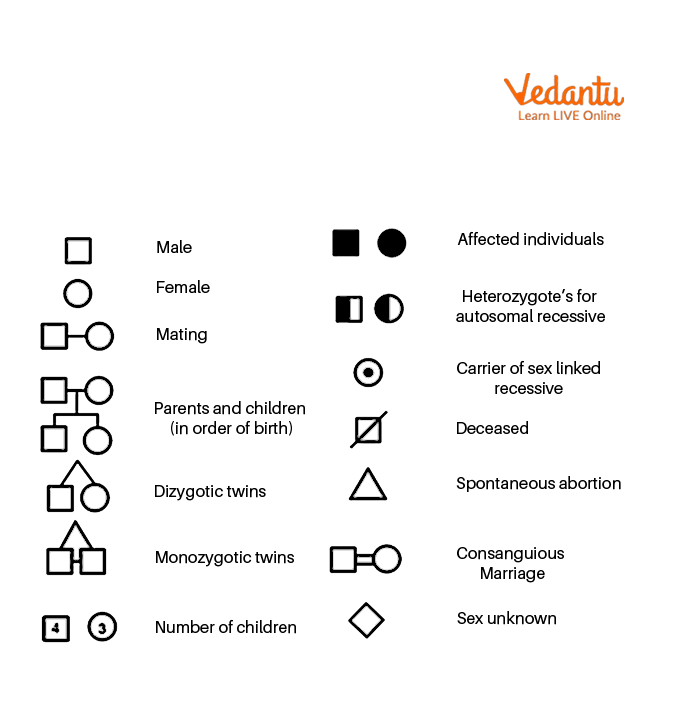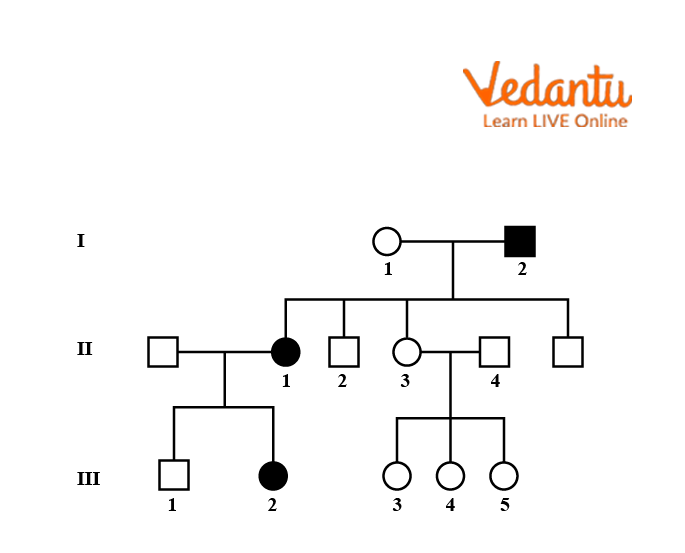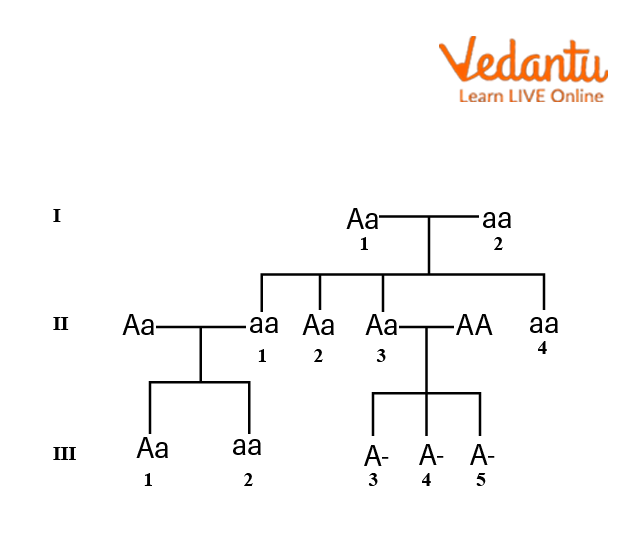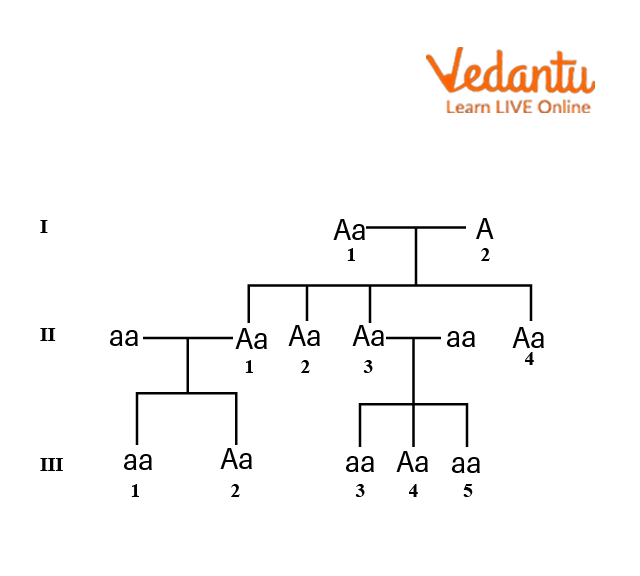




CBSE Biology Experiment - Pedigree Chart of a Genetic Trait
You must have heard about the royal disease. Queen Victoria of England was a carrier of haemoglobin B. She passed this trait of haemophilia B to her three children out of nine. Do you know about pedigree? A pedigree is a record of the inheritance of some genetic traits for two or more generations in the form of a diagram called a pedigree. Now this pedigree chart is used to find out these inherited disorders. That's why close relatives are advised to not marry. Because it may lead to the expression of some recessive characteristics.
Table of Content
Aim
Articles Required
Theory
Procedure
Observations
Result
Precautions
Lab Manual Questions
Viva Questions
Practical Based Questions
Conclusion
Aim
The experiment aims to prepare and study pedigree charts of any one of the genetic traits such as rolling of tongue blood groups, earlobes, widow's peak, and colour blindness
Articles Required
Information about the above-mentioned traits in the family
Theory
Pedigree
Pedigree is the record of genetic traits for two or more generations in the form of a family tree.
There are different symbols used for human pedigree. Some of these symbols are explained below:

Symbols used in pedigree analysis
Different symbols used for pedigree analysis
A square represents male
Circle represent female
Parents are represented by horizontal lines whereas
Children are represented by the vertical line
The shaded symbol represents a trait under study
Each generation is represented by roman numerals.
Procedure
Select a family with any one of the traits such as ear lobes, widow peak, colour blindness, blood group
Ask questions from family members who exhibit these traits in their family
Prepare a pedigree chart based on information collected from the family
Then at the end examine the pedigree chart carefully whether traits are autosomal, sex-linked, recessive, or dominant
Problem 1- Inability to Roll Tongue
The trait of inability to roll the tongue appears in the progeny due to recessive genes. Now we have to find out the possible genotypes of these family members.

Pedigree chart
Solution: Now we can see in this pedigree chart that the father has the trait of the inability of rolling the tongue so the genotype of the father in 1st generation is homozygous recessive. Now one of the children in 2nd generation has this trait so she must be homozygous recessive and the remaining children in 2nd generation are heterozygous recessive. So mothers in the 1st generation would be heterozygous recessive. Now, the 2nd child in the 3rd generation has this trait, so she would be homozygous recessive. 1st Children of the 3rd generation would be heterozygous recessive and 3rd, 4th, and 5th children of the 3rd generation may be heterozygous or homozygous.
It is an example of an autosomal recessive pedigree.

Solution of pedigree chart of inability to roll tongue trait
Problem 2 - Widow Peak
The pedigree chart for a particular family is given below. Indicate whether the shaded symbols belong to dominant or recessive traits.

Pedigree chart of widow peak trait
Solution: Since the shaded symbols appear in all offspring, the father must be homozygous dominant and the mother homozygous recessive because in all other cases the possibility is absent. All the members of the 2nd generation will be heterozygous. This is further confirmed by the marriage of II-I with homozygous recessive-bearing children of both parental types. Marriage of II-3 with the homozygous recessive can produce both recessive and heterozygous.

Solution of widow peak trait
Observations
Genotypes of various members of the family for a particular trait have been observed.
Results
The pedigree charts of two families have been studied.
Precautions
First, carefully analyse the family tree and then write the genotypes.
Lab Manual Questions
Q1. What is a pedigree?
Ans: A pedigree is a record of the inheritance of a particular trait over two or more generations in a given family.
Q2. What does a horizontal line represent in a pedigree?
Ans: Horizontal line represents parents in a pedigree.
Q3. What is the importance of pedigree analysis?
Ans: Pedigree analysis helps in knowing the possibility of the presence of a particular trait in a homozygous or heterozygous state in family members.
Viva Questions
Q1. What is pedigree analysis?
Ans: It is a process of analysing the inheritance pattern of a family member over several generations to show the origin of a trait.
Q2. What is the conclusion of pedigree charts?
Ans: Pedigree chart can conclude the pattern of inheritance, it helps to find out whether the given trait is dominant or recessive or autosomal or sex linked trait.
Q3. What is linkage?
Ans: Linkage is defined as the closeness of genes to one another on the chromosome. The more the closeness between the genes on a chromosome, more will be the linkage.
Q4. What are mendelian disorders?
Ans: Mendelian disorders are the disorders that appear due to abnormalities in genes, or chromosomes. Examples of Mendelian disorders are cystic fibrosis and sickle cell anaemia.
Q5. What is the purpose of pedigree?
Ans: The main purpose of a pedigree chart is to analyse or find out the pattern of inheritance of a particular trait in a given family.
Q6. Give an example of an autosomal dominant pedigree
Ans: Autosomal dominant diseases include - Huntington's chorea and marfan syndrome. In Huntington's disease nerve cells of the brain break over time.
Q7. Colour blindness pedigree chart given in practical book is dominant or recessive?
Ans: Colour blindness is a X- linked recessive disorder.
Q8. What is a pedigree chart called?
Ans: Pedigree chart is also called a family tree.
Practical Based Questions
Q1. What does the symbol square represent in a pedigree analysis?
Female
Male
Both
None of the above
Ans: 2. Male
Q2. What are different types of genotypes?
Homozygous dominant
Homozygous recessive
Heterozygous
All of the above
Ans: 4. All of the above
Q3. What does the circle represent in pedigree?
Male
Twin
Female
None of the above
Ans: 3. Female
Q4. What does horizontal line represent in a pedigree?
Children
Marriage
Divorce
All of the above
Ans: 2. Marriage
Q5. What does a vertical line represent in a pedigree?
Marriage
Children
Separation
None of the above
Ans: 2. Children
Q6. What are genes made of?
DNA
Protein
Carbohydrates
All of the above
Ans: 1. DNA
Q7. What are the sources of genetic variation?
Recombination
Mutation
Both of the above
None of the above
Ans: 3. Both of the above
Q8. There are how many alleles of a gene?
One
Two
Three
None of the above
Ans: 2. Two
Conclusion
We have discussed pedigree and pedigree analysis in this experiment.
Different symbols used for the pedigree analysis also discussed in this experiment
There are many types of genetic disorders, such as homozygous, heterozygous, dominant, and recessive
Two problems of pedigree were also discussed in this experiment, inability of rolling tongue and widow peak.






FAQs on Preparing Pedigree Charts of Any one of the Genetic Traits
1. What is the meaning of X-linked recessive traits? Give some examples.
X-linked traits are those traits whose are genes present only on x chromosomes. These traits are only expressed by homozygous females and homozygous males. Now females are the most carriers of these types of traits and males are mostly got affected by these types of traits. Now if females are carriers then 50% of sons will be affected. If the female is homozygous 50% of daughters and 100% of sons will be affected. Examples of x- linked recessive diseases are haemophilia and colour blindness.
2. What are the four types of pedigree?
The four types of pedigree are explained below:
Autosomal dominant - Dominant traits do not skip generations. These traits are present in every generation and expressed whenever genes are present. In this condition, we can get the particular trait if we have only one gene of this trait
Autosomal recessive - These traits are present only when offspring inherit genes from both parents.
X - linked recessive - These traits are only expressed by homozygous females and hemizygous males.
X- linked dominant - In this inheritance is vertical and is found in all generations
3. What symbols are used in the pedigree?
Various symbols are used in the pedigree analysis. Some of the symbols are provided below:
A female is represented by a circle.
A male is represented by a square.
If figures are shaded, it indicates that a particular trait is present. A black or shaded circle represents a diseased female, and a shaded or black symbol represents a diseased male. Aan deceased individual is represented by a diagonal line in a square or circle. Marriage is represented by a horizontal line between a square and a circle. A vertical line represents children.






















